
The Renault RS01 raced for the first time at the 1977 British GP was powered uniquely in F1 by a 1.5 litre V6 Gordini turbocharged engine. Its failure in the race saw the team miss the next two races to work on the car before returning to qualify an impressive tenth at the Dutch GP.
|
| 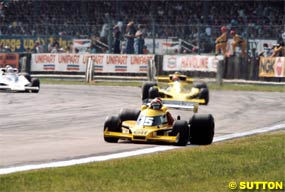
35 year-old Jean-Pierre Jabouille was called upon to debut the turbocharged Renault RS01 at the 1977 British GP. The car lasted 16 laps before its turbo blew. Frequent subsequent turbo problems saw other teams dismissively dub the Renault as the 'Yellow teapot.'
|
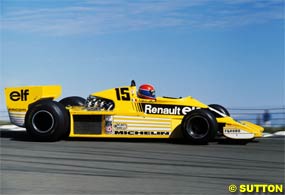
A year of frustrations for the Renault team in 1978 was tempered when Jean-Pierre Jabouille brought home the extensively developed Renault RS01 in fourth position, securing the first ever F1 points for the French team.
|
| 
The Renault team celebrate as Jean-Pierre Jabouille crosses the finish line to take the Regie's first ever GP victory at the 1979 French GP at Dijon. The race though is better remembered for the titanic battle between Gilles Villeneuve and Jabouille's teammate Rene Arnoux for second position.
|
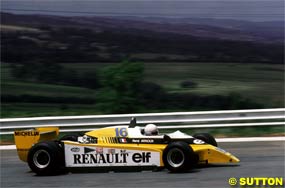
When Rene Arnoux cruised to his second victory in succession early on in the 1980 season at Kyalami, the World Championship looked a real possibility. However poor reliability and problems with their Michelin rubber meant that he and teammate Jabouille rarely threatened for the remainder of the season.
|
| 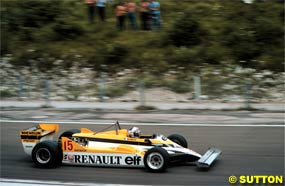
New French sensation Alain Prost took his first victory on home soil at Dijon in 1981. Prost took two further victories but the Renault turbocharged car had developed an infamous reputation for being very fast but fragile.
|

Renault took four victories in 1982 and was the quickest package of the season but again suffered woeful reliability. Here pole sitter Rene Arnoux emerged unharmed from a spectacular crash at Tarzan in the Dutch GP when a wheel fell off!
|
| 
Alain Prost celebrates his fourth victory of the 1983 season at the Osterreichring. Prost came closest to giving Renault a World Drivers Championship, losing out in the final round to Nelson Piquet at Kyalami. Prost's victory at Austria would be the last for Renault as a constructor for 20 years.
|
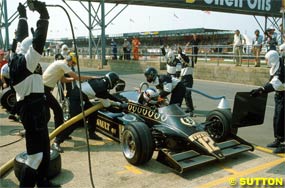
Significantly in 1983 Renault decided to sell their turbocharged engines to Lotus. Nigel Mansell got his hands on the Lotus 94T with Renault turbo power for the first time at the British GP and finished in a fine fourth position.
|
| 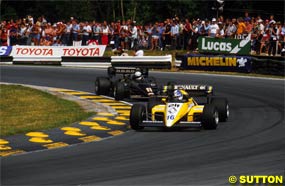
Three second place finishes were the high point for Renault in 1984 including this one for Derek Warwick at the British GP. Too often though the Renault powered Lotus team outclassed them.
|
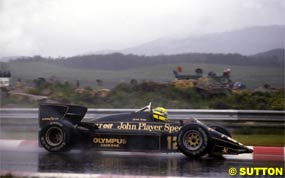
As the Renault works team faltered badly in 1985, it continued to be the Renault powered Lotus team who made the best use of the turbocharged engines, such as when Ayrton Senna took a memorable first victory at the very wet Portuguese GP.
|
| 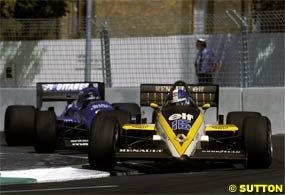
After a disastrous season the Renault team pulled out from Formula One at the end of the 1985 Australian GP. Renault powered Ligiers and a Tyrrell highlighted the strength of the engine though by finishing second, third and fourth.
|
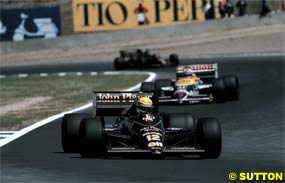
Thanks to the genius of Ayrton Senna, Renault enjoyed continued success powering the Lotus team, enabling the Brazilian to take the first of four victories in 1986 at Spain. At the end of the season though Renault withdrew completely from F1.
|
| 
Renault returned to F1 in 1989 supplying a normally aspirated V10 engine to the Williams team. The package was encouragingly competitive from the onset as Thierry Boutsen took two wet victories, the first of them at Montreal in the Canadian GP.
|

Williams and Renault took a further two victories in 1990, including a popular win for Riccardo Patrese at the San Marino GP. The team were however someway off being truly competitive with McLaren and Ferrari.
|
| 
With Nigel Mansell back at Williams-Renault the team was able to push McLaren and Ayrton Senna for the 1991 World Championship. The season not only became a titanic struggle between drivers and teams, but also of engine suppliers, as Renault and Honda worked tirelessly throughout the season to develop more power.
|
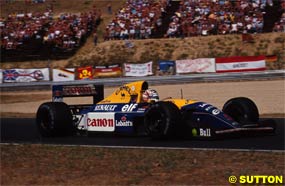
Nigel Mansell finished second in the 1992 Hungarian GP using the all-conquering Williams FW14-B with updated RS4 Renault engine to take his first World Championship and the first for Renault.
|
| 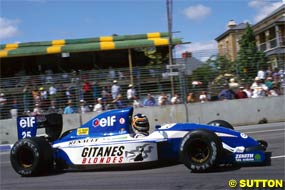
In 1992 Ligier paid to use the same championship winning Renault engines as the Williams team. However the all-French partnership proved less successful than their Anglo-French counterparts as they achieved mediocre results for three consecutive seasons.
|

Renault and Williams continued their domination of F1 in 1993 when Alain Prost rekindled his Renault association after ten years apart to claim his fourth World Championship title before retiring from the sport.
|
| 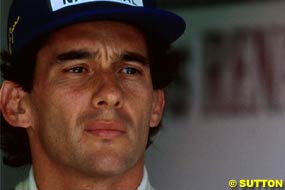
What should have been a formidable combination ended in tragedy when Ayrton Senna was killed at the wheel of a Williams-Renault during the 1994 San Marino GP. The team recovered to some extent but the championship went to Benetton-Ford and Michael Schumacher.
|
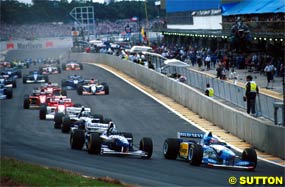
With Benetton acquiring Renault engines from their purchase of Ligier, they ensured that Renault enjoyed their most successful ever season in 1995 as Williams or Benetton won all but one of the seventeen Grand Prix and Michael Schumacher claimed his second world title.
|
| 
In 1996 it was Damon Hill's turn to secure the coveted drivers' World Championship crown as the Williams-Renault combination regained its number one status in Formula One.
|
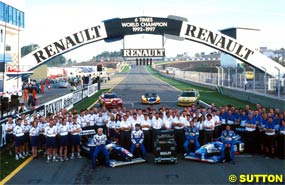
With Jacques Villeneuve securing a dramatic World Title for Williams-Renault at the final round of 1997 at Jerez, Formula One said goodbye and thank-you to Renault as they officially withdrew from F1 after six championship winning seasons.
|
| 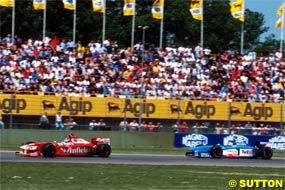
Renault were represented in F1 from 1998 to 2000 by the Mecachrome company, who had prepared customer engines for Renault since 1983. The engines were also badged as Playlife by Benetton and then Supertec from 1999. The engines, used by Williams, Benetton, BAR and Arrows were based on the 1997 Renault V10 and provided podium finishes but no victories.
|
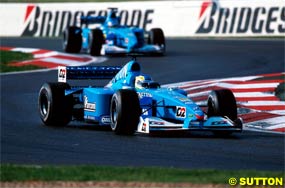
At the beginning of the 2000 season Renault bought the Benetton team. However Benetton continued to run with Supertec engines with relatively little success as preparations were made for the following season.
|
| 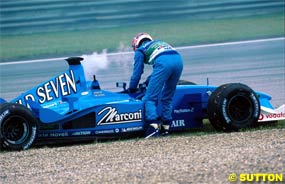
The Benetton name remained for the 2001 season but the year was essentially a development period for Renault and their new wide-angle 111-degree engine. New recruit Jenson Button in particular suffered through this transition period, which would be the least successful in the history of Benetton.
|

The yellow of Renault returned to F1 in 2002 but the blue of Benetton was still evident as the chassis and aerodynamic work on the Renault R202 continued at Enstone in Oxfordshire. The season was an improvement as the team finished fourth in the constructors' championship.
|
| 
Young Spaniard Fernando Alonso claimed Renault's first victory as a constructor in 20 years after a supreme performance at the 2003 Hungarian GP. The team was the biggest improver of the year as Alonso and teammate Jarno Trulli regularly battled for podium places.
|






























